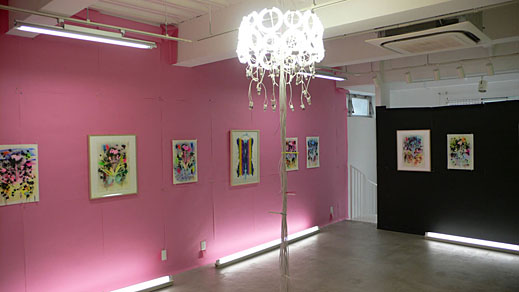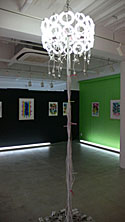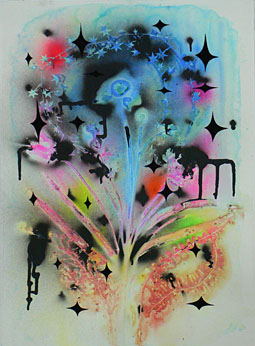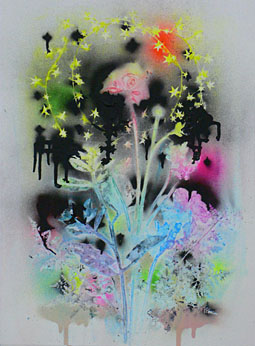 |
Focus features two in-depth reviews each month of fine art, architecture and design exhibitions and events at art museums, galleries and alternative spaces around Japan. The contributors are non-Japanese art critics living in Japan. |
|
|
 |
 |
 |
In Praise of Fluorescence: Yuichi Higashionna
Roger McDonald |
 |
 |
| fluorescent, installation view at NADiff Gallery 2F, 2010 |
In "Other Criteria" (Artforum, March 1972) Leo Steinberg referred to the paintings of the young Robert Rauschenberg as "flatbeds," after printing presses. Steinberg was pointing to an important shift in contemporary painting which could be likened to the way different modules are placed on the printer's block, arranged and edited, thereby changing the psychic address of a picture from a vertical to horizontal plane. Rather than being "painted" as such, these new kinds of pictures were composed or built up using many different elements -- photographs, objects, drawings, bits of newspaper. Steinberg interestingly wrote about these kinds of pictures as surfaces "on which data is entered." Extending the language of Cubism and collage into the age of instant mass communications, this "flatbed" mode of working extends deep into contemporary painting practice.
|
 |
|
fluorescent, installation view at NADiff Gallery 2F, 2010 |
Yuichi Higashionna's drawings, prints and canvases may be related to this flatbed lineage. Working in Tokyo since the early 1990s, Higashionna has slowly matured a unique visual grammar that explores his interest in postwar Japanese middle-class life, its interiors and what he refers to as a fanshii aesthetic. Drawing on Western tastes and styles, but transformed for a Japanese market, the fanshii style was marketed aggressively by companies such as Sanrio (makers of Hello Kitty) in the 1980s, producing vast lines of decorated stationery, toiletries and towels. The fancy goods market reached an estimated turnover of 10 trillion yen in 1990, according to a report in the January 5, 1991 edition of The Japan Times. Depending on one's reading, the fanshii boom cultivated during this period formed the bedrock upon which contemporary kawaii styles emerged.
Higashionna's latest prints and drawings present some of his signature techniques and materials, including the use of fake flowers and chains, which are used as stencils with spray paints to form negative imprints, and the use of fluorescent, psychedelic color combinations. Black dripping paint and the mist-like traces of the spray pull the "fancy" decorative motifs down into a kind of uneasy, sickly space. I was reminded of the indexical works of the American Philip Taaffe, who uses natural objects as repeating motifs in highly decorative and abstract compositions. But whereas Taaffe's pictures tend towards a repository or archival project, Higashionna's images seem more like negative impressions of the various innocuous objects he mirrors.
Another obvious visual reference is the psychedelic poster art of the late 1960s and 1970s. Higashionna's images employ many of its devices -- the "optical flicker" effect, which is generated when two colors of equal value are placed adjacent to each other, or the dense layering of different motifs which seems to dissolve boundaries between objects. While the posters of artists such as Victor Moscoso or Michael English tend towards a heightening of visual pleasure by flooding the eye with ornamental images, Higashionna's pictures seem somehow less about giving pleasure and more akin to mementos or relics. It is interesting that many of the works contain a centrally placed group of flowers, like those left on a gravestone. In this aspect his images again address the viewer as vertical images, rising up from being empty data fragments on a flatbed.
The title of the exhibition, "fluorescent," suggests bright lights, the glare of the convenience store, and its corresponding associations with gaiety and kitsch: all aspects of modernity which Jun'ichiro Tanizaki railed against in his famous "In Praise of Shadows." These works extend Higashionna's long investigation into the "impure" fancy aesthetic, moulding a unique, rather formal kind of Op-Art that is strangely non-physical and built on the empty fragments of recent Japanese consumer culture.
 |
|
 |
| untitled (fl.s.d-021), acrylic, spray paint, collage on paper, 54x38 cm, 2009 |
|
untitled (fl.s.d-022), acrylic, spray paint, collage on paper, 54x38 cm, 2009
All photos courtesy of Yumiko Chiba Associates
|
|
 |
 |
Roger McDonald
Roger McDonald was born and brought up in Tokyo, educated in the UK, and returned to live in Japan in 2000 after completing his PhD. He has worked on the Yokohama Triennale 2001 as assistant curator, the Singapore Biennale 2006 as curator, and organised a number of exhibitions and projects independently. He is deputy director of the non-profit curatorial collective Arts Initiative Tokyo, and teaches at Musashino and Joshibi Art Universities. |
|
 |
|